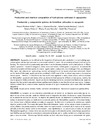Identificador persistente para citar o vincular este elemento:
https://accedacris.ulpgc.es/handle/10553/41981
| Campo DC | Valor | idioma |
|---|---|---|
| dc.contributor.author | Martínez-Yáñez, Rosario | en_US |
| dc.contributor.author | Albertos-Alpuche, Pedro J. | en_US |
| dc.contributor.author | Guzman-Mendoza, Rafael | en_US |
| dc.contributor.author | Robaina-Robaina, Lidia E. | en_US |
| dc.contributor.author | Alvarez-Gonzalez, Alfonso | en_US |
| dc.contributor.author | Diaz-Plascencia, Daniel | en_US |
| dc.date.accessioned | 2018-09-20T08:12:59Z | - |
| dc.date.available | 2018-09-20T08:12:59Z | - |
| dc.date.issued | 2018 | en_US |
| dc.identifier.issn | 2007-901X | en_US |
| dc.identifier.uri | https://accedacris.ulpgc.es/handle/10553/41981 | - |
| dc.description.abstract | Aquaponics can be defined as the integration of hydroponic plant production in a recirculating aquaculture system and has been proposed as a sustainable method to control the accumulation of waste produced by fish farming. The objective of the present study was to determine the biomass production and its feed potential of Myriophyllum aquaticum, Limnobium laevigatum, Lemna minor and Salvinia molesta grown in aquaponics. To evaluate the chemical compositions of these species, dry matter, organic matter, crude protein, neutral detergent fiber, acid detergent fiber, lignin, ash, ether extract, gross energy, calcium, and phosphorus of the aquatic plants were determined. Based on the results of this study, aquatic plants are considered to fulfill most of the nutritional requirements of productive animal species. Therefore, it is feasible to use them as the main ingredient in whole animal rations, with an emphasis on Myriophyllum aquaticum and Lemna minor as alternative food sources for different animal species, opening the way to aquaponic fodder production. Aquatic plants are interesting alternative, unconventional feed sources, especially because their high growth rates and nutritional qualities make it feasible to use them for animal consumption. However, Salvinia molesta has no value as fodder, especially because of its lignin concentration, which could affect the fodder digestibility. | en_US |
| dc.description.abstract | La acuaponía es una alternativa sustentable para el control de los desechos acumulados que se producen en los cultivos acuícolas, puede ser definida como la integración del cultivo de plantas en camas hidropónicas en un sistema de recirculación acuícola. El objetivo del presente estudio fue determinar la producción de biomasa y evaluar el potencial forrajero por medio de la composición química de Myriophyllum aquaticum, Limnobium laevigatum, Lemna minor y Salvinia molesta cultivadas en acuaponía. Se determinó el contenido de materia seca, materia orgánica, proteína cruda, fibra neutro detergente, fibra ácido detergente, lignina, cenizas, extracto étereo, energía bruta, calcio y fósforo. Las plantas acuáticas evaluadas cubren los requerimientos nutricionales de la mayoría de las especies animales productivas, siendo posible su incorporación como ingredientes en las raciones para animales, en particular Myriophyllum aquaticum y Lemna minor son una alternativa para la alimentación animal, como forrajes acuapónicos. Las hidrófitas son una fuente no convencional y alternativa de forraje, por su rápido crecimiento y calidad nutrimental, para el consumo animal. Mientras que Salvinia molesta, no tiene valor como forraje por su concentración de lignina, lo que afecta su digestibilidad. | en_US |
| dc.language | eng | en_US |
| dc.publisher | 2007-901X | |
| dc.relation.ispartof | Ecosistemas Y Recursos Agropecuarios | en_US |
| dc.source | Ecosistemas y recursos agropecuarios [ISSN 2007-901X], v. 5 (14), p. 247-257 | en_US |
| dc.subject | 251092 Acuicultura marina | en_US |
| dc.subject.other | Aquatic plants | en_US |
| dc.subject.other | Biomass | en_US |
| dc.subject.other | Fodder | en_US |
| dc.subject.other | Nutritional characterization | en_US |
| dc.subject.other | Recirculation aquaculture systems (RAS) | en_US |
| dc.subject.other | Plantas acuáticas | en_US |
| dc.subject.other | Biomasa | en_US |
| dc.subject.other | Forrajes | en_US |
| dc.subject.other | Caracterización nutrimental | en_US |
| dc.subject.other | Sistemas de recilculacion acuicola (SRA) | en_US |
| dc.title | Production and chemical composition of hydrophytes cultivated in aquaponics | en_US |
| dc.title.alternative | Producción y composición química de hidrófitas cultivadas en acuaponía | en_US |
| dc.type | info:eu-repo/semantics/Article | es |
| dc.type | Article | es |
| dc.identifier.doi | 10.19136/era.a5n14.1447 | |
| dc.identifier.isi | 000437111800008 | - |
| dc.description.lastpage | 257 | - |
| dc.identifier.issue | 14 | - |
| dc.description.firstpage | 247 | - |
| dc.relation.volume | 5 | - |
| dc.investigacion | Ciencias | en_US |
| dc.type2 | Artículo | en_US |
| dc.contributor.daisngid | 7332005 | |
| dc.contributor.daisngid | 33338731 | |
| dc.contributor.daisngid | 4349874 | |
| dc.contributor.daisngid | 34488856 | |
| dc.contributor.daisngid | 8504058 | |
| dc.contributor.daisngid | 8082687 | |
| dc.contributor.wosstandard | WOS:Martinez-Yanez, R | |
| dc.contributor.wosstandard | WOS:Albertos-Alpuche, PJ | |
| dc.contributor.wosstandard | WOS:Guzman-Mendoza, R | |
| dc.contributor.wosstandard | WOS:Robaina-Robaina, LE | |
| dc.contributor.wosstandard | WOS:Alvarez-Gonzalez, A | |
| dc.contributor.wosstandard | WOS:Diaz-Plascencia, D | |
| dc.date.coverdate | Enero-Abril 2018 | |
| dc.identifier.ulpgc | Sí | es |
| dc.description.esci | ESCI | |
| item.grantfulltext | open | - |
| item.fulltext | Con texto completo | - |
| crisitem.author.dept | GIR Grupo de Investigación en Acuicultura | - |
| crisitem.author.dept | IU de Investigación en Acuicultura Sostenible y Ec | - |
| crisitem.author.dept | Departamento de Biología | - |
| crisitem.author.orcid | 0000-0003-4857-6693 | - |
| crisitem.author.parentorg | IU de Investigación en Acuicultura Sostenible y Ec | - |
| crisitem.author.fullName | Robaina Robaina, Lidia Esther | - |
| Colección: | Artículos | |
Citas de WEB OF SCIENCETM
Citations
5
actualizado el 08-jun-2025
Visitas
86
actualizado el 27-jul-2024
Descargas
177
actualizado el 27-jul-2024
Google ScholarTM
Verifica
Altmetric
Comparte
Exporta metadatos
Los elementos en ULPGC accedaCRIS están protegidos por derechos de autor con todos los derechos reservados, a menos que se indique lo contrario.
